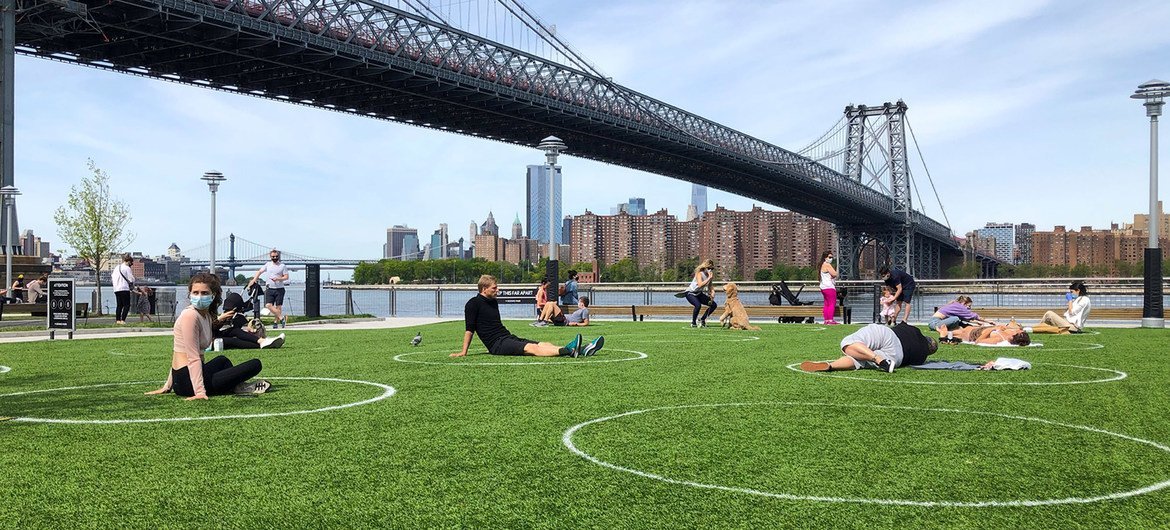Younger peoples need to be convinced of Pandemic risk:WHO chief

A park in Brooklyn, New York, has marked out circles in order to enforce social distancing during the COVID-19 pandemic.
30 July 2020
Although older people are among those at highest risk of COVID-19, the head of the World Health Organization (WHO) has reminded younger generations that they are “not invincible” when it comes to the disease.
Evidence suggests that the spike in cases in some countries is partly due to younger people “letting down their guard during the northern hemisphere summer”, WHO chief Tedros Adhanom Ghebreyesus said on Thursday.
“We have said it before and we’ll say it again: young people are not invincible”, he told journalists.
“Young people can be infected; young people can die; and young people can transmit the virus to others.”
He stressed that the world’s youth “should be leaders and drivers of change” during the COVID-19 pandemic.
Protect yourself and others
Tedros further advised that people everywhere must learn to live with the virus, and to take steps necessary to protect themselves and others, including those who are most at risk, such as the elderly and people in long-term care.
Many countries have reported that more than 40 percent of COVID-19-related deaths have been linked to long-term care facilities, and up to 80 per cent in some high-income countries.
In response, WHO has released a policy brief on preventing and managing COVID-19 in those facilities.
It lists key actions such as integrating long-term care in national response plans to counter the pandemic, ensuring strong infection prevention and control, and providing support for family and voluntary caregivers.
The brief also suggests ways to transform long-term care services so that older people can receive quality care that respects their rights, freedoms and dignity, Tedros added.
Experts to advise on behavioural insights
Twenty-two international experts in fields such as anthropology, psychology, neuroscience and health promotion will help WHO understand how people make decisions that support their health and well-being, including during the pandemic.
The newly established Technical Advisory Group on Behavioural Insights and Sciences for Health, announced aon Thursday, will support WHO’s ongoing work in this area.
Tedros explained that while having reliable information about health is important, people make decisions based on a variety of factors, influenced by culture, beliefs, economic circumstances, or the status of national health systems.
“In the face of the COVID-19 pandemic, countries are using a range of tools to influence behaviour: information campaigns are one tool, but so are laws, regulations, guidelines and even fines”, he said.
“That’s why behavioural science is so important – it helps us to understand how people make decisions, so we can support them to make the best decisions for their health.”
American legal scholar and former top US Government official Cass Sunstein chairs the Technical Advisory Group, whose members come from 16 countries.
“Our starting point…is that health involves behaviour. And whether we’re speaking of COVID-19, or sexual and reproductive health, or smoking, or other non-communicable diseases, human behaviour is at the root of it”, said Professor Sunstein, who is founder and director of the Program on Behavioral Economics and Public Policy at Harvard Law School.
“We know that habits are persistent, even if they aren’t healthy. And we know from a great deal of work that habits can be altered – and that can save lives.”
Eid al-Adha and a safe Hajj
Tedros also extended best wishes to all Muslims celebrating the annual Eid al-Adha festival, which falls on Friday.
He commended Saudi Arabia for implementing measures to make this year’s Hajj pilgrimage as safe as possible.
“This is a powerful demonstration of the kinds of measures that countries can and must take to adapt to the new normal”, said the WHO chief.
“It’s not easy, but it can be done. The pandemic does not mean life has to stop."
Labels: WHO, Younger people and COVID-19




